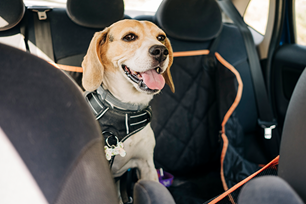Why does my dog get motion sickness?
While you may not see your dog turn pale like humans do when they’re feeling nauseous, there are tell-tale signs when they’re “turning green!” Drooling, pacing, whining, smacking or licking their lips are signs that your dog is feeling motion sick and it might be a good time to pull over to let your dog get some fresh air and relieve their stress.
Motion sickness is common with dogs and typically has two causes: the feeling of loss of balance and car-related anxiety.
Reducing anxiety and preventing motion sickness is possible with a method called counter-conditioning. Essentially, you want to help your dog feel comfortable, safe and less anxious when heading to the car. Here are our tips to help you get on the road:
- Place your dog in your vehicle and give them a few treats, while praising them profusely for their good work. Repeat this a few times until you dog is happily pulling toward your vehicle rather than away!
- Line your pet’s crate or lay their favorite bed or blanket on the seat and consider trying an Adaptil® collar or spray. Adaptil® is a pheromone that mimics natural canine appeasing pheromone that helps support dogs in stressful situations. Ask your veterinarian for more information on using pheromones.
- Next, it’s time to start your engines! Once you’ve secured your dog (in their crate or with a harness/seatbelt system), start the engine, turn on the air conditioning (or heat) and maybe play some soft music. Sit in your vehicle for a few minutes and make sure that you give your dog some treats and lots of praise. Again, repeat this sequence a few times until your dog seems comfortable heading to the car.
- Now it’s time to try a trip around the block. Once you have your dog secured and the playlist is queued, head out for a short trip—emphasis on short! Praise your dog while driving and when you’re back home, give them a treat to reward them for being such a good co-pilot! Repeat this several times and gradually increase the trip length. Take it slow. You can’t rush a pet to “get over” their anxiety.
- Keep calm and use a soft voice.
- Before travel, withhold food for 12 hours, but always offer fresh water. An empty stomach may help reduce nausea and the need for frequent potty breaks during long trips.
- If your pet still seems to be feeling a little green when going for a drive, speak to your veterinarian for recommendations. Your veterinarian can give you more tips or prescribe medication, such as anti-nausea or anti-anxiety medications that can help your pet ride easy!
Counter-conditioning can take some time, but it’s well worth the effort to help your dog feel better when traveling for short or long periods of time!
Is your feline companion getting used to traveling? Check out our guide to motion sickness in cats. >>
